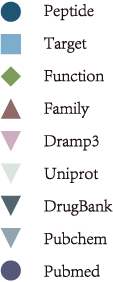Cyclo[Ala-D-Leu-Athr-Athr-Tyr-Gly-Ala-Pro]
Basic information
| CPKB ID | CP02423 |
| IUPAC Name | (3S,9S,12S,15S,18R,21S,24S)-12,15-bis[(1S)-1-hydroxyethyl]-9-[(4-hydroxyphenyl)methyl]-3,21-dimethyl-18-(2-methylpropyl)-1,4,7,10,13,16,19,22-octazabicyclo[22.3.0]heptacosane-2,5,8,11,14,17,20,23-octone |
| Source |
Annona squamosa [Division : Plants and Fungi]
Taxonomy :301693 (Viridiplantae-Streptophyta-Magnoliales-Magnoliopsida-Annonaceae Annona) Wikipedia: Annona squamosa PubChem |
| Information |
Cyclo[Ala-D-Leu-aThr-aThr-Tyr-Gly-Ala-Pro] is a natural product found in Annona squamosa with data available. |
Legend

Structure
download
| Molecular Formula |
C36H54N8O11 |
| Molecular Weight | 774.3912045 g/mol |
| SMILES | CC(C)C[C@H]1NC(=O)[C@H](C)NC(=O)[C@@H]2CCCN2C(=O)[C@H](C)NC(=O)CNC(=O)[C@H](Cc2ccc(O)cc2)NC(=O)[C@H]([C@H](C)O)NC(=O)[C@H]([C@H](C)O)NC1=O |
| InChI | InChI=1S/C36H54N8O11/c1-17(2)14-24-32(51)42-29(21(6)46)35(54)43-28(20(5)45)34(53)41-25(15-22-9-11-23(47)12-10-22)31(50)37-16-27(48)38-19(4)36(55)44-13-7-8-26(44)33(52)39-18(3)30(49)40-24/h9-12,17-21,24-26,28-29,45-47H,7-8,13-16H2,1-6H3,(H,37,50)(H,38,48)(H,39,52)(H,40,49)(H,41,53)(H,42,51)(H,43,54)/t18-,19-,20-,21-,24+,25-,26-,28-,29-/m0/s1 |
| InChIKey | XLTMDOFLUKZVOQ-VRKCIBGFNA-N |
|
2D Structure
PubChem|162999804
|
|
|---|
Sequence
| IUPAC Condensed | cyclo[Ala-D-Leu-aThr-aThr-Tyr-Gly-Ala-Pro] |
| Amino acid chain | Ala(1)--D-Leu--aThr--aThr--Tyr--Gly--Ala--Pro(1) |
| Graph representation | Ala,D-Leu,aThr,aThr,Tyr,Gly,Ala,Pro @0,7 |
| One letter code from Structure | APALTTYG |
| Amino acid chain from Structure | Leu(1)--Thr--Thr--Tyr--Gly--Ala--Pro--Ala(1) |
| Description of the conversion sequence | The one letter code and Amino acid chain derived from the structural transformation may be inconsistent, with the Amino acid chain containing Essential Amino acid and the one letter code not. |
| svg Image |
Structure Properties
| Property Name | Property Value | |
|---|---|---|
| Exact Mass | 774.3912045 | |
| Number of Rings | 3.0 | |
| Complexity | 0.672727273 | |
| XlogP3 AA | -3.1882 | |
| Heavy Atom Count | 55.0 | |
| Hydrogen Bond Donor Count | 10.0 | |
| Hydrogen Bond Acceptor Count | 11.0 | |
| Rotatable Bond Count | 6.0 |
| Property Name | Property Value | |
|---|---|---|
| Formal Charge | 0.0 | |
| Refractivity | 195.3043 | |
| Rule_of_Five | 0.0 | |
| Number of Atoms | 55.0 | |
| Topological Polar Surface Area | 284.7 | |
| Refractivity | 195.3043 | |
| Veber Rule | 0.0 | |
| Ghose Filter | 0.0 |
| Property Name | Property Value | |
|---|---|---|
| RDKit Fingerprint |
01000010101000100100100011011000110000100111010000101010100001101110101111101100100110010010110010000101000001001010001000110010000001001100110100001111000110000100001010100110100110001111100100100100101001001000000100000000010101000101001110001100011100101111000110001000000010001001100000000010011010011010101101000001010100000010111011010110111000000010011000000001000010000000101001000010010100000100000110001100000010100000101000111011110011100000000100010110111000010100000000000010001110010100100000101101110001100100111010010101101110100100100010010110001001000110010010001001000010111100101000110001101010011000100000001011100100110100000011100110000001000110001010000000010101001100011100110010100101100000000100101011001001011001100010001010001110101010001110010000000001100001001010001000001000001000100000001001111011110000010011101001011000110010011100100001010100000100111000000011001101000010111000010100011110011010000000011110001010001011011101010000011000010110001010000001010100000000000000101101001111110011110110111011100000001010000000001110101001100001000001001001110110000001001101010010000000101000000110001001010000010100101000001000100110100110101111001001010010001110000001001000000101001101010011100000011100110111000010010000100101000110001000000100000000110000110001011001011010100001000001100010100001000011111110000001010110110011010000010000000101011000001000000101100101001100000001000101100011001000001011111010001101001011001100000110010000100001110000111111011001000000100100100111000011100000001000010000011110100100000010100000000110100111001001010101100010000001000010100001000000100010110000000100000000100010010010000001000011000100101010000101000010000001011110100100100101000001010110001000100000100011011001010101010010010110100010000000100001010110100000000011111101101100000010110010011110100111110011000000100000000000110011100000010000001101101100000100101101000001010010010101000010000111110110000001011001011011001001000011001001100110000101001000100010010000000011101110000100100100111000010011 |
|
| Morgan Fingerprint |
0100110000100000000100000000000001000000000000010000000000000000000000000000000010000000001000100000010000000000010100000000000000000000000000000000000000000000000000000000000000000000000000000000001000000000000000000000000000010001000000000000000000100000000000000000000000000000000101001100000000000100000000100010000001000000000000010000100000000000000010000000000000000000000000000000000000000000000000000000000000000000000000001001000010000010000000001010000000000000000000000010000000001000000000010001000000000001000000000000000000000000000000010000000000000000000000000010000000000000000000000000000000000000000000000000000000100000000000000010000000000000010000000000000000001001000000100000000000000000000100000000001000100000000000000100000000100010000000000000000000000000000000000000000000000001000000000000100100000000000000000010000001001000000000000000000000000000000000000000000100000000000000000000000000000010000000010000000000000000001001000000000000000000000000001000000000000000000000000000000000010000 |
|
| MACCS Keys |
00000000000000000000000000000000000000000000000000000110000000000000000000100001001101000111100111001000110010110101011011100001110110001111111100111111111111111111110 |
Sequence Properties
| Property Name | Property Value | |
|---|---|---|
| Boman Index | -0.525 | |
| Instability | 46.2875 | |
| Charge | -0.00286611482556564 | |
| Aliphatic Index | 73.75 |
Manufacturers
| Manufacturers Name | Value | |
|---|---|---|
| CreativePeptides | ||
| Bayer healthcare pharmaceuticals | ||
| Upsher smith laboratories | ||
| Merck |
| Manufacturers Name | Value | |
|---|---|---|
| Apotex | ||
| Baxter Healthcare Corp | ||
| Pharmasources | ||
| Novartis | ||
| AstraZeneca |
Forecasting tools
| Forecasting tools | Value | |
|---|---|---|
| Structure to Sequence | ||
| Structure Properties | ||
| Sequence to Structure | ||
| Sequence Properties | ||
| Expasy ProtParam Tool | APALTTYG | |
| SEA | RUN SEA Predictions |
Information Source
| Property Name | Property ID | |
|---|---|---|
| Patents | XLTMDOFLUKZVOQ-VRKCIBGFNA-N | |
| pubchem | 162999804 | |
| Drugbank | ||
| DRAMP3 | ||
| Uniprot | ||
| Cybase | ||
| CONOSERVER | ||
| BindingDB | ||
| CHEMBL | ||
| CTD | ||
| Wikipedia | ||
| KEGG Compound/Drug | ||
| CHEBI | XLTMDOFLUKZVOQ-VRKCIBGFNA-N | |
| EPA DSSTox | ||
| FDA Global Substance Registration System (GSRS) | ||
| DTP/NCI | ||
| Chemspider | XLTMDOFLUKZVOQ-VRKCIBGFNA-N |
Reference
| Pubmed_ID | Title | DOI | Journal | |
|---|---|---|---|---|
12475187 |
10.1081/clt-120014646. | J Toxicol Clin Toxicol |
||
Treatment of amatoxin poisoning: 20-year retrospective analysisAbstract
|
||||
24613547 |
10.1016/j.toxicon.2014.02.020. | Toxicon |
||
The molecular diversity of toxin gene families in lethal Amanita mushroomsAbstract
|
||||
